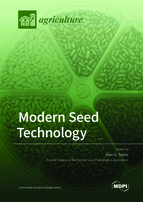Modern Seed Technology
A special issue of Agriculture (ISSN 2077-0472). This special issue belongs to the section "Crop Production".
Deadline for manuscript submissions: closed (20 February 2021) | Viewed by 84401
Special Issue Editor
Special Issue Information
Dear Colleagues,
Satisfying the increasing number of consumer demands for high quality seed with enhanced performance is one of the most imperative challenges of modern agriculture. In this view, it is essential to remember that the seed quality of crops does not improve after harvest. Therefore, a deeper understanding is of crucial importance on how to manipulate the post-harvest factors with the aim to maintain and/or maximize the seed quality prior to sowing. Post-harvest seed enhancements can improve germination and vigor, protect seed and seedlings from biotic and abiotic stress, and improve seed singulation and precision seeding.
This Special Issue focuses on the development and assessment of post-harvest methods in determining the seed quality of crops, and enhancing seed and seedling performance resulting in high and stable quality. This issue on Modern Seed Technology will include interdisciplinary studies embracing agriculture with disciplines of biology, chemistry and engineering. Research articles will cover a broad range of seeds from specialty crops, including vegetable crops, ornamental and hemp as well as field crop, and seeds from other managed ecosystems. All types of articles, such as original research, opinions, and reviews are welcome.
Prof. Dr. Alan G. Taylor
Guest Editor
Manuscript Submission Information
Manuscripts should be submitted online at www.mdpi.com by registering and logging in to this website. Once you are registered, click here to go to the submission form. Manuscripts can be submitted until the deadline. All submissions that pass pre-check are peer-reviewed. Accepted papers will be published continuously in the journal (as soon as accepted) and will be listed together on the special issue website. Research articles, review articles as well as short communications are invited. For planned papers, a title and short abstract (about 100 words) can be sent to the Editorial Office for announcement on this website.
Submitted manuscripts should not have been published previously, nor be under consideration for publication elsewhere (except conference proceedings papers). All manuscripts are thoroughly refereed through a single-blind peer-review process. A guide for authors and other relevant information for submission of manuscripts is available on the Instructions for Authors page. Agriculture is an international peer-reviewed open access monthly journal published by MDPI.
Please visit the Instructions for Authors page before submitting a manuscript. The Article Processing Charge (APC) for publication in this open access journal is 2600 CHF (Swiss Francs). Submitted papers should be well formatted and use good English. Authors may use MDPI's English editing service prior to publication or during author revisions.
Keywords
- seed treatments
- film coating
- pelleting
- enhancements
- biostimulants
- seed quality
- storage
- stand establishment
- seedling vigor






